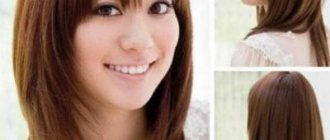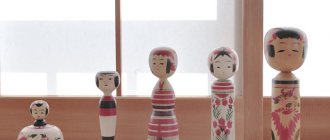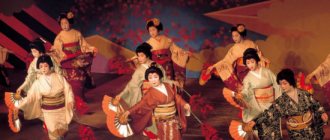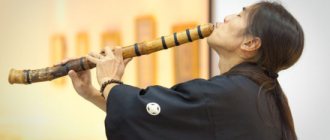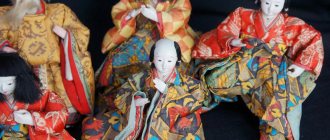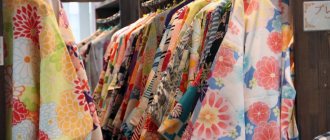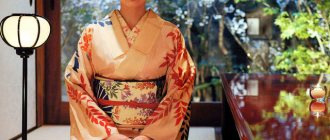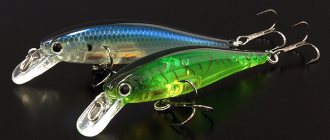Peach, green and closet color: traditional Japanese colors
What subtext is hidden behind the colors of the kimonos of beauties from the prints of the Heian and Edo eras? What was the emperor’s personal color and why did the aristocrats establish a monopoly on a number of bright and rich shades? We'll tell you here in a short guide to traditional Japanese flowers.
Under traditional flowers, or dento:shoku
(伝統色), refers to a range of shades that have been used since ancient times in Japan in the production of textiles and clothing, in decorative and applied arts, in painting, etc. Such shades are often found in prints and literature, and it is not surprising, because there is a cultural background behind them, and the mention of a certain color can say a lot to native speakers. For example, the phrase “his head was crowned with a purple headdress,” found in a text from the Heian era (794–1185), ambiguously hinted at the origin and status of the person in question.
It is difficult to say definitively how many colors are considered “traditional”, but there are clearly more of them than those to which we are accustomed.
But it all started long before purple and other violet shades. The oldest colors that the Japanese began to widely use are considered to be the quartet of red, blue (or a spectrum of bluish-greenish shades), black and white.
Even in modern Japanese the importance of these colors can be traced. Most flower names in Japanese are formed using the word 色iro
“color”: 茶色
cha-iro
“brown”、灰色
hai-iro
“gray”.
And only these four colors do not need further clarification and are simply called 赤いakai
, 青い
aoi
, 黒い
kura
, 白い
shira
.
The importance of this set of colors is also indicated by Japanese proper names: if a color is mentioned in the surname, most likely it will be one of the four listed above. They also appear more often in proverbs and sayings. In addition, it is these four colors that form stable combinations with the hieroglyph 真 (“true”, “pure”): 真っ赤makka
“bright red” and 真っ青
masao
“rich blue”, 真っ黒
makkuro
“completely black”, 真っ白
massiro
“snow white”.
However, the perception of colors by the ancient Japanese was quite different from our modern one. It is believed that these four words, which today we perceive as the names of specific colors, initially indicated not shades, but the degree of brightness. Yes, okay
could actually mean "light",
kuroi
- "dark",
siro
- "bright", and
aoi
- "pale".
Therefore, the Japanese, looking at the shining sun at its zenith, can say 真っ赤な太陽makka-na taiyo:,
which will indicate exactly the brightness, and not the scarlet hue.
The diverse nature of the Japanese archipelago with its humid climate could not help but be reflected in the Japanese language, and gradually the Japanese began to invent more and more shade names. A significant part of the names were invented starting from the Kofun era (250–538).
Monopoly on colors
Until a certain point, the colors used by the Japanese in everyday life were, for the most part, accessible to everyone. Prince Shotoku hastened to correct this, who in 603 (Asuka era, 538–710) introduced the Twelve Ranks System. She classified the Japanese nobility into twelve grades and ordered that aristocrats of each rank wear headdresses of their own color. Prince Shotoku borrowed his system, not surprisingly, from China, and in this new hierarchy one of the fundamental concepts of Chinese philosophy could be traced with the naked eye - the concept of the five elements, or Wu-hsing.
Wu-sing interpreted the five elements, namely wood, fire, earth, metal and water, as the main elements of the universe. These elements corresponded to the ancient colors already familiar to us: blue/green like wood, red like fire, metal like white and water like black, but the concept of Wu-sin made one addition. She brought in yellow to match the earth. This is how the yellow color came to Japan and became one of the most important colors (we’ll talk about how important later), along with the four most ancient shades.
Along with the twelve ranks, the Shotoku system introduced “forbidden colors” (禁色kinjiki
), which were allowed to be worn only by those who were assigned a high aristocratic rank.
Commoners were prohibited from using kinjiki. The only exceptions could be those who received permission to wear some color from the emperor himself. The remaining colors, that is, those that could be worn by everyone, regardless of origin and rank, were called yurushiiro
(許し色) - “permitted colors.”
One of the winter combinations of kasane no irome “Under the Snow” is a combination of white and pink plum color.
Aristocrats of the Heian era had to follow strict rules regarding colors and outfits, and one of them was the observance of color combinations in clothing - 襲の色目kasane no irome
. This concept can be translated as “layer colors”. The Heian nobility, especially the aristocrats, combined the colors of the many layers of their clothing in a certain way depending on the seasons, and thus the combinations of kasane no irome appeared.
The twelve rank system was not the only set of laws that imposed restrictions on the use of colors. Prohibited and permitted colors have varied over time, but in most cases the prohibited colors are the following.
Prohibited colors
The most forbidden of all the forbidden flowers was “ sumac color.”
", or 黄櫨染
ko: rozen
, - it could only be worn by the emperor. This color still remains an attribute of Japanese monarchs, and the outer ceremonial clothing worn by emperors upon accession to the throne is today painted exclusively in this yellow-brown-orange shade, close to ocher.
Sumac became the personal color of the Japanese emperors a little later than the Shotoku rank system was introduced - the ceremonial clothes of monarchs began to be dyed in this color starting from the Heian era (794-1185), which echoes a similar tradition in China.
The next most inaccessible color to both ordinary people and the nobility was yellow-red color
(黄丹
o:dan
,
o:ni
). It could only be worn by Japanese crown princes, and during ceremonies they invariably wore an outer robe of this color.
Some colors could be banned only because they were made using the same ingredients and were too similar to shades that were already considered prohibited. One of these flowers was the color of gardenias
(支子色
kutinashi-iro
). Gardenias were also a major ingredient in the production of o:dan dye, reserved for Japanese crown princes, and although a different composition was used to achieve the gardenia color, the shades were considered too similar and the color of gardenias also became prohibited.
Pale green
(
acorn) color
(青白橡
aoshiro-tsurubami
, or 麹塵
kikujin
) was quite popular at court. It was worn by lords, samurai, sometimes even servants, as well as the emperor himself. Because emperors' outerwear was often dyed this shade for special occasions, it has been suggested that at some points in history the pale green was only available to the monarch. In Heian literature, this shade appears simply as 青色 (“green” or “blue”).
Dark purple color
(深紫
fukamurasaki
,
kokimurasaki
) has long been considered the color of the Japanese nobility. It was made from the roots of a Japanese plant of the sparrow genus, a rather expensive ingredient. The more times the fabric was dyed with the dye, the more saturated the shade became, making the fukamurasaki color even more rare and valuable.
Pale red (acorn) color
(赤白橡
akasiro-tsurubami
) is another “imperial color”, which, in addition to the current monarch, could also be worn by ex-emperors. In the second half of the Heian era, regents and advisors were allowed to wear robes of this color during banquets and trips, but only on the condition that the emperor's costume on that day was of a different color. In the literature of the Heian era (794–1185), this shade of pale red was meant by “red color” (赤色).
Dark red color
(深緋
fukahi
,
kokihi
,
kokiake
) were worn by mid-level dignitaries, and gradually it became associated with them. It could also be seen on samurai - for example, in “The Tale of the House of Taira” dark red armor is mentioned.
Dark sappan color
(蘇芳
suo:)
was also worn exclusively by the nobility in the Heian era (794–1185). This shade was achieved thanks to sappan (mahogany) wood. In the collection of instructive stories "Konjaku-monogatari" this color meant the color of blood that was about to coagulate.
All other Japanese could wear the permitted colors, but what could you do if you really, really wanted to wear a scarlet or purple kimono, but you couldn’t? Here ingenuity came to the aid of people from among the people. By mixing different dyes, they achieved similar shades, usually representing less saturated and lighter versions of the forbidden colors, which could not be faulted. For example, take the already mentioned dark red shade of fukahi. Mahogany, its main component, was a cheaper material than sparrow root, which was used to make the purple dye. However, mahogany provided a similar deep undertone and was used to achieve those forbidden and expensive, yet coveted purple shades. Thanks to similar experiments, the so-called “false purple” (偽紫nise-murasaki)
) and other fake shades.
During the Meiji era (1868–1912), along with the class system, the ban on people of “low birth” wearing certain colors was also abolished. Only the sumac color of the emperor and the yellow-red color of the crown princes remained untouched. They remain inaccessible to ordinary people today.
Even without knowing the distinctive features of the imperial costume, you can now identify the Japanese monarch in the engraving. Meet, for example, Emperor Go-Daigo and, of course, his sumac-colored robe.
But both modern Japanese and their ancestors had plenty to choose from. It is quite difficult to estimate the number of colors that are considered traditional in Japan: numbers range from 300 to 500. Each traditional color has its own name, associated mainly with the names of plants and animals, parts of which were used to make the dye. It is quite difficult to find analogues for such colors, and the literal translation of their names can cause a slight shock. Here are a few of our favorites:
海老茶 ebitya – literally “shrimp tea color”. Already in the Meiji era, it was often used in the uniform skirts of female students. There is another way to write the word – 葡萄茶, “grape tea”, which sounds less wild.
This beautiful aquamarine-turquoise color has an even more mysterious name in Japanese. You are ready? This is 納戸色 nando-iro - “closet color”.
Literally, the name of the shade 鬱金色 ukon-iro can be translated as “depressive gold.” But if you look closely at the history of this name, it turns out that 鬱金 is “turmeric”, and the color itself was not associated with depression (the modern meaning of the kanji 鬱), but with money and enrichment.
There's not much to say about the shade 鴨の羽色 (kamo-no-ha iro), except that the name "duck wing color" is quite cute.
Of course, there is a place for poetry in the names of traditional Japanese flowers. This shade, for example, is called 千歳緑 chitose-midori - “thousand-year green”. Who wouldn't want to try one on themselves?
These are just a few colors from the widest palette of Japanese traditional colors. You can find out more about them here and here. Traditional colors are still actively used in fashion and art today, you just need to take a closer look. Write which shade you liked the most!
Sources:
日本語の色の言葉は4色しかなかった?
日本の伝統色とは?
日本人の美の心!日本の色
有職の「かさね色目」
Japanese Traditional Colors
Why is purple considered the color of samurai? Meaning of flowers in Japan
Wow, summer holidays are just beginning, and the trend towards “boring contemplation of dust particles flying around the house” is already taking place. To prevent this from happening, AniDUB (um, in my person) has prepared something interesting.
In the last issue we talked about unnatural hair color in Japan (remember that?). And, in order to finally clarify this confusing and complex (without any sarcasm) issue, today’s article will talk about the Japanese meaning of color and its connection with anime (direct and indirect, by the way). Well, enough ranting, it's time to test yourself for the title of Anime Character Connoisseur !
In Japan , as a rule, paints are named not by the materials from which they are made (for example, ocher, indigo, cobalt - those in the know will understand), but by the natural carriers of color. So, “arahairo” is “the reverse side of leaves and herbs,” “uguisuiro” is “the color of the wings of a Japanese nightingale,” and “sabiiro” is “rust” (all that remains is to learn this and show off in front of the art store seller). Residents of the islands notice and recognize colors and combinations that other cultures have not even thought about (there is an opinion that men do not distinguish between different shades. But this clearly does not apply to the Japanese). But today we will get acquainted with only some of them (otherwise we could write an encyclopedia). Well, let's go?
Yellow (黄 – “ki”) is the color of gold, a symbol of the sun (unexpectedly), divine power and mercy. Once upon a time , Japan was called the land of gold or Zipangu (ジパング - there is such an anime, by the way). This name is associated with the name of Marco Polo, who prompted the Portuguese, who trusted his word, to visit this distant continent. In his letters, he wrote about Japan as a country where “gold is scattered everywhere” (oh, greedy people!). Well, the inhabitants of Portugal, coveting wealth, arrived on the islands and thereby strengthened their (meaning, the islands) relations with Europe.
Yellow hair color indicates the royal origin (how unexpected!) of the character and the presence of hidden potential. And such heroes are smart (not always, however), careless, selfish and vindictive (this most often applies to negative participants).
Red (赤 – “akai”) is the color of danger, anger and rage (the Japanese break stereotypes). The ancient Japanese, by painting objects red, scared away the devil himself. Maybe this is why many talismans and amulets are associated with the color of akane (茜 which means “madder” - paint was made from the root of this plant). So, for example, the tumbler doll Daruma (達磨) - a red figurine of a meditating priest - brings good luck and happiness (this is without any details). When purchasing, one eye is painted over and a wish is made, and when it comes true, it is the turn of the second (the eyes are meant).
In anime, red-haired guys are considered lovers of female attention (womanizers, to be honest), and girls are considered representatives of royal blood.
Blue (青 – ao) is the color of meanness, fraud (not always, of course) and modesty.
From the beginning of the 17th to the middle of the 19th century, the Japanese government strictly regulated the lives of its citizens, burdening them with a set of rules and prohibitions. So, for example, ordinary people had to wear kimonos only in discreet colors, which tradition included blue . But the Japanese were smart and created a huge number of patterns and shades of “simple” colors for variety. By the way, even after the restrictions were lifted, indigo silk kimonos did not appear in Japan until the beginning of the 20th century (when the time came for the inheritance of careless granddaughters keeping traditions).
Characters with blue hair are shy and taciturn, constant towards their companions (loyal to them, in general) and strong-willed. True, these are not found in nature (meaning blue hair color).
Green (緑 – “midori”) is the color of immortality, fertility, spring and prosperity, the color of freshness and eternal youth. This “turn” has to do with trees (again, nothing surprising). Residents of the Land of the Rising Sun believe that tree representatives have a soul - kodama (児玉 or “echo”) and that the gods descended from heaven along the branches of giant oak trees (in fact, the type of tree is not exactly known).
Wearers of green shades (on the head, actually) are naive and simple-minded. They trust everyone they meet and often get into trouble (of course). True, more often than not, they themselves get out of them.
Black (黒 – “ kuro ”) is the color of joy and happiness (we continue the line of surprise). It is in black attire that the newlyweds learn the sacrament of marriage, and mothers dress for the wedding in luxurious black kimonos with woven birds or flowers.
The Japanese often refer to the color " kenpo " (拳法 - " law and fist " or " constitution "), which is similar to ordinary black. In fact, it is black with an admixture of yellow - it was in this shade that the Kyoto fencing master Yoshioka Kempo painted the combat clothing of his students (in fact, this reflection got its name from the last name). Kempo is considered a camouflage color that is inaccessible to the non-Japanese eye (bad luck for you and me, comrades).
Anime - brunettes are the embodiment of perseverance, fearlessness and self-control (no, no, no), sometimes they are stern and cold towards the people around them. Black-haired youths usually rebel and go against the system, showing the spirit of real punks - aggressors (sounds kind of creepy).
White (白 – “ shiro” ) is the color of divine origin, the color of death, mourning and sorrow. In white robes, the Japanese accompany the deceased on their last journey in order to transport them to the bright world of spirits - the holy abode of the gods (such a contrast compared to our perception).
Heroes with white usually harbor unusual abilities (why am I not surprised?) and are often connected with other worlds (angels, animals, spirits). They can also be called phlegmatic (they are stingy with feelings, as the legend says).
Purple (紫 – murasaki, can also be translated as “bell”) is the color of warriors, nobility and strength. In Japan, the only flowers that could be given to a samurai were delicate irises . The leaves of this plant are thin and sharp and resemble the blade of a trusty katana. These flowers symbolize joy and good luck to the faithful (and not so faithful) guardian of Bushido. Also, “ iris ” and “fighting spirit” are denoted by the same hieroglyphs (sort of like 闘志).
Purple hair gives its owner determination and a tendency to violence (including against himself, so). Such people can also be weak and submissive (even after violence).
Pink (東雲 – sinonome or “dawn”) is the color of the morning dawn, the emergence of new life, the indestructibility of the passage of time. As I already said, the Japanese vision of color involves an incredible number of shades. So, in this case we are talking about one of these “shade representatives” of pink. Shinonome is the color of power and strength, born in Japan , and as such carries a “combat” burden. "Dawn" is often used in the names of warships (for example, the pair " Sinonome " and "Usugumo" - the Battle of Port Arthur) or the names of sumo wrestlers.
As fate would have it, pink-haired characters have the indestructible strength of their inner “I” with apparent innocence and purity (they’re faking it!). Their actions are thought out and logical, and their combat skills are quite great. When properly combined, such heroes make excellent super agent warriors.
Phew , it wasn't easy, but you, dear reader, have reached the end of this masterpiece. And, since you’re here, I’ll make a few amendments to the narrative (so that your inner voice doesn’t scream: “Why! He had green hair!” or “No, all this is nonsense, the author is writing some kind of nonsense”). Firstly: if some of the characters are “out of their color category”, I apologize, because I am a little colorblind (and have not watched all the anime presented). And secondly , I think that knowledgeable fans of the AniDUB
They will come to the rescue and make the necessary amendments (but without fanaticism!).
Well, see you soon, your Arma :3
